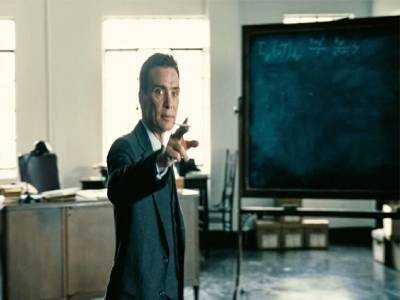[ad_1]
An alien civilization spying on humans using quantum entanglement. A planet chaotically orbiting three stars. Nanofibres capable of slicing through Earth’s hardest substance, diamond. Despite being chock-full of hardcore science, 3 Body Problem, a television series released on 21 March by the streaming service Netflix, has been a hit with audiences. So far, it has spent five weeks straight in Netflix’s list of the top-three programs viewed globally.
The science of Oppenheimer: meet the Oscar-winning movie’s specialist advisers
The story follows five young scientists who studied together at the University of Oxford, UK, as they grapple with mysterious deaths, particle-physics gone awry and aliens called the San-Ti who have their sights set on Earth. But how much of the science in the sci-fi epic, based on the award-winning book trilogy Remembrance of Earth’s Past by the Chinese writer Cixin Liu, reflects reality, and how much is wishful thinking? To find out, Nature spoke to three real-world scientists.
Xavier Dumusque is a planetary scientist at the University of Geneva in Switzerland who has studied the three-star system Alpha Centauri. Younan Xia is a materials scientist at the Georgia Institute of Technology in Atlanta who has worked with cutting-edge nanotechnologies. Matt Kenzie is a particle physicist at the University of Cambridge, UK — and was the scientific adviser for 3 Body Problem.
Kenzie originally met two of the show’s creators, David Benioff and D. B. Weiss, 14 years ago, while the pair were filming the popular fantasy saga Game of Thrones. Kenzie’s father was a director of photography for that series, and Benioff and Weiss chatted to Kenzie on set. “I was doing my PhD at the time,” Kenzie recalls, and they seemed interested in his thesis project. More than a decade later, “they e-mailed me sort of out of the blue, asking about some of the particle-physics stuff” in 3 Body Problem.
Full disclosure: spoilers ahead.
What do you think of the portrayal of scientists and their relationships in the series?
Kenzie: The lazy way of portraying scientists on screen [in other programs and films] is as lone geniuses. For a lot of modern research, it’s not like that. The fact that the characters all know each other and are very friendly because they did their PhDs together in the same group seems very plausible. I also think most physicists are socially very capable. We work in bigger and bigger teams. You need to be able to communicate, you need to be able to lead if you’re in a successful academic position, you have to be able to basically convince someone to fund your research, whether it’s by hiring you or by giving you funding.
Barbie and body image: a scholar’s take on the research — and the blockbuster film
One thing that’s probably not true to reality is that there are quite a few women — about half women — and a good mix of ethnic backgrounds in the actual cast of the show. The truth, sadly, is that [physics graduates] probably would be 70% white males at a place like Oxford. But, you know, we hope that that is improving. And I don’t think there’s any harm in the show trying to progress standards by displaying something a little bit more diverse.
Dumusque: Something that I liked, and it’s a little bit true, is that there are five former physics PhD students, and, in the end, there are only one or two that are still doing fundamental physics. All the others are doing other things — they are all successful. That’s the reality. I had ten close friends finishing PhDs, and now we are only two left in academia. The others are doing plenty of super-interesting things.
The San-Ti emerge from a planet in the three-body Alpha Centauri system. We’re told this means they’ve had a chaotic existence as their planet was flung between stars. Would aliens actually survive this?
Dumusque: Alpha Centauri is indeed a triple system, which has two bright stars, Alpha Centauri A and B, and a tiny star, Proxima Centauri, which is closest to us [at 1.3 parsecs away]. In fact, it was not clear for a long time if the third star, Proxima, was bound to the system — because it’s very, very far away, really at the limit of the system. The gravitational interaction of Proxima on the two main stars is extremely small. So what they’ve shown in the show — you have all this instability due to the third body — in reality, it doesn’t happen in this system.
There is a planet around Proxima, and it’s an interesting planet because the star is much smaller and cooler than our Sun. So although the planet is orbiting it with a period of just around 15 days, the surface temperature of the planet is more or less 0 °C. In terms of temperature, it could be habitable [although not comfortable]. But small stars like Proxima have a lot of magnetic activity and flares, and give out a lot of X-rays, all of which does not favour life.
The way Earth initially contacts the San-Ti is by amplifying a radio signal using the Sun. Is that possible?
Dumusque: I think it should be possible, but not in the way the 3 Body Problem shows. We can use the effect of gravitational lensing — if there is an object passing behind the Sun, we could use the mass of the Sun to amplify the [radio signal]. But it would be amplified just in one specific direction [rather than in all directions, as shown in the program].
The San-Ti, called Trisolarans in the books, unleash high-tech particles called sophons that use quantum entanglement to observe and communicate with Earth in real time. Is this feasible?
Kenzie: The mechanism shown has been proven, and I think will soon be deployed in what is known as quantum satellite technology. You’re basically sending signals incredibly fast using entangled particles, where, when you measure the state of one, you immediately know the state of the other. However, there is still a caveat to that, which is that you cannot communicate faster than the speed of light.
[To ‘read’ the distant particle] you still need to send an electromagnetic signal to decode the information [which travels at the speed of light]. Trisolarans circumvent this by knowing about hidden dimensions. They have a way of tunnelling through or exploiting those dimensions. So it appears like they’re communicating faster than light in our three- or four-dimensional Universe (if you include time as the fourth dimension).
Younan, you haven’t seen the series yet, but you’ve watched a clip in which nanofibres made by one character slice through a huge chunk of diamond as if it were cake. Are we there yet?
Xia: First, the size of the diamond you saw in that clip, that’s impossible! If you can make that size of a diamond, I’m sure you can easily become a billionaire. As far as I know, no material has been made that’s harder than diamond. Scientists have dreamt about finding a material to beat diamond for decades. They have even identified some compounds, like [a particular type of] carbon nitride, using computer simulations, that could work, but these materials cannot be synthesized in the lab. Maybe there are some formulations of compounds that would work, materials we just don’t know of yet.
People have also thought a carbon nanotube could be stronger than diamond. But that kind of strength is a ‘stretching’ strength and is not really suitable for cutting applications. Carbon nanotubes are rolled up sheets of graphene. But most of them are pretty short in terms of length. So far, it’s been difficult to make them even a few centimetres long without defects; I don’t know how they could’ve made these fibres [in the program].
Matt, as the scientific adviser, were you happy with how the series turned out?
Kenzie: The writers of this show really know a lot about science. They’re very well read, and they think about things very carefully. They’re not just asking [me for advice] to make themselves feel better, they really think about things. The level of attention to detail that they showed was something that impressed me. I was not really expecting it, to be honest.
[ad_2]
Source Article Link



